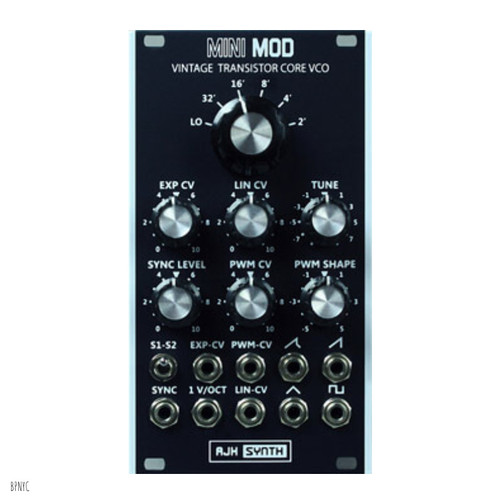Product Overview
Please ask how to order!!
9U Full system
Building on the 6U system, this case offers 3 rows (9U), adding an extra VCO, VCF, VCA, and even more modulation. This system also features a complete MiniMod voice, but with enough modules to add an additional, distinctly different voice to play along side it. It can do everything the 6U system can do, but with the Wave Swarm’s dual waveform animators, wave-folding diode filter, and ‘clockable’ multi-waveform, voltage-controlled LFO, this system offers a huge increase in capability. Such configurations might include:
- A 2-voice polysynth, with each voice featuring 2-VCOs, 2 envelopes, and their own matching waveform animator/multiplier (Wave Swarm), LFO, VCF and VCA..
- Two huge sounding 2-VCO monosynths, each with distinctly different characteristics and voice architecture. One serving as a lead synth, the other controlled by a sequencer with syncopated filter modulation (Tap Tempo VC-LFO).
- Three modest, completely separate mono voices, with their own modulation, all melodically controlled, or perhaps one providing a clocked percussive beat or sound effects.
- One ridiculously huge sounding, 4 VCO and 2 sub-octave monosynth! Or perhaps, in order to preserve the structure of nearby architecture, patching a range of variations of the sound sources through the various filters and Wave Swarm, then bringing them together via the Muting Mixer, so that multiple sounds could be selected during a performance.
This system is a real powerhouse, with an absolutely huge range of sonic and performance possibilities.
Here's a breakdown of the modules, case and power supply used in this system:
- Glide Noise Glide / Noise Module - Glide up and down, CV buffereing and splitting, White, Pink and Red Noise Source
- 4 x MiniMod VCO - The best sounding Analogue VCO based on the early RA Moog circuitry.
- MiniMod Transistor Ladder Filter - An absolute legend, based on the early MiniMoog filter.
- Dual Contour Generator - two independant envelopes using Model D transistor circuitry
- 2 x Discrete Cascaded VCA - two stage VCA using early MiniMoog circuitry
- Dual LFO with VCA - Provides two multi waveform LFO's along with a DC coupled VCA forextra level control
- CV Mixer with VCA - mix, invert, amplify and attenuate CV voltages
- Ring SM - Our award winning Ring Modulator, Dual Sub Bass generator and five channel CP3 discrete transistor mixer
- Sonic XV - Vintage style Diode Ladder filter and Wavefolder
- Tap Tempo LFO - Amazing Voltage Controlled LFO with Tap Tempo, 16 waveforms and VCA
- Precision Voltages Module - Transpose and mix pitch CV's wth sufficient accuracy to keep everything perfectly in tune
- Muting Mixer and VCA - Both a mixer and a Linear / Exponential VCA
- WaveSwarm - 6 x 2 channel Waveform animators, make 1 VCO sound like twelve!
- Gemini 2412 - Hugely versatile Dual Multimode VCF based on the vintage Oberheim SEM circuitry
- Gain Switch Multi - Control Overdrive of the MiniMod VCF and VCO, and passive multi
- 2 x DH-ADSR Envelope - Envelope with Delay, Hold and invert features, this also allows the system to be configured as two voices
- Case - Doepfer A100 LC9V Vintage Black case, 9U with three rows of 84HP for a total of 252HP of rack space
- Power supply - Doepfer PSU3 extra low noise power supply and distribution rails, suitable for 230V or 115V operation
Specification
Dimensions: 44.5 cm x 42 cm x 16 cm
9U with 3 rows of 84HP, total of 252HP rack space.
Weight: 9.0 kg
Voltage: 100V to 240V, auto sensing
Notes on patch cables for 9U system:
Patch cables are a very personal choice, so we supply our systems without these, however here is a suggestion of suitable sizes to get started:
10 of 25-30cm,
10 of 50-60cm,
4 of 80-90 cm
The 4 longest cables will be useful for connecting the CV & Gate outputs of a controller or sequencer to the CV IN of the Glide + Noise or 1V/Oct of a VCO, and the GATE inputs of the contour/envelope generator modules. This system can easily be used as 2 separate synth voices, so having a pair of cables for these purposes is helpful. Also, one could be used to connect the clock output of a sequencer to the CLK IN of the Tap Tempo VC-LFO, but it could also be sent a duplicate of the Gate signal triggering an envelope by using the multiple.
The short cables will be most useful for connecting VCOs & noise to the Ring SM or filters, and the envelope generators to VCAs or filter frequency inputs - since these are mostly in close proximity to each other, it will reduce cable overhang, and so make accessing the pots easier. Otherwise, the medium-length cables will comfortably reach from one side of the case to the other, accommodating connections where the shorter cables cannot reach.







